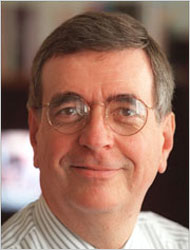
Clark Hoyt, The New York Times public editor, wrote another column this month about the newspaper's sourcing issues.
Editor & Publisher wrote – in an unsigned editorial May 19, 2003 – that the New York Times is addicted to anonymous sources. Maybe it’s true because the New York Times Public Editor Clark Hoyt can’t seem to stop writing about it.
April 17, Hoyt wrote yet another column on The New York Times’ overuse, misuse, and abuse of anonymous sources. His view is very clear. He wrote that the Times is “squandering” its readers trust by “misusing” anonymous sources. Hoyt states:
“The Times continues to use anonymous sources for information available elsewhere on the record,” Hoyt wrote. “It allows unnamed people to provide quotes of marginal news value and to remain hidden with little real explanation of their motives, their reliability, or the reasons why they must be anonymous.”
But, Hoyt acknowledges, anonymous sources can serve a valid role. He also noted that anonymous sources “recently helped The Times break a scandal involving Gov. David Paterson of New York. But used casually or routinely, they stir readers’ skepticism.”
And, in an example Hoyt didn’t mention in his column, New York Times reporter James Risen was subpoenaed April 29 by the Obama administration for the confidential sources used in his book State of War: The Secret History of the C.I.A. and the Bush Administration, the New York Times reported.
As Firedoglake reported, this is the second time Risen has been subpoenaed for this information.
Hoyt has been public editor since May 2007. Outside of publishing numerous readers’ letters on the newspaper’s use of anonymous sources, Hoyt has written at least six columns in the past thirteen months on sourcing.
- Most recently, Hoyt wrote in that April 17, 2010 column that the Times’s misuse squanders its readers trust.
- Hoyt wrote Jan. 30, 2010 on his issues with the second-hand sourcing in the book Game Change.
- Two weeks earlier, on Jan. 16, he wrote that the Times needs to be more careful checking out any external conflicts of interests sources might have.
- He wrote Oct. 17, 2009 that anonymous sources were used in reporting in descriptions of Raymond Clark III, accused of murdering Yale grad student Annie Le, as well as descriptions of Robert Joel Halderman, accused of blackmailing David Letterman. “These tidbits seemed at best like gossip and at worst unfair suggestions of motive or guilt,” Hoyt wrote. “When the comments are anonymous, the potential unfairness can be compounded because readers have no way to evaluate the motives or credibility of those doing the talking,” Hoyt wrote.
- In Aug. 15, 2009, he wrote that sometimes the use of anonymous sources in the Times is “too casual, in violation of the paper’s own high standards.”
- And on March 28, 2009, he wrote about anonymous sources in political coverage. “Washington, where I have reported and edited (and used my share of unnamed sources) for the better part of the last 40 years, is a city steeped in the culture of anonymity,” Hoyt wrote. Hoyt cited deputy Washington bureau chief Richard Stevenson that some anonymous sources are “human press releases.”
Following Hoyt’s March 28, 2009 column, Messy Matters wrote that while Hoyt noted The New York Times’ use of anonymous sources had roughly halved since 2004, Messy Matters’ count found that the Times’ use had “steadily grown” since 2000.
Messy Matters wrote that it thought the difference in statistics is from sources requesting anonymity versus “designated anonymity- in which reporters fail to name a source despite their willingness to be cited (e.g., abstract references to ‘expert’ opinion).”
In 2004, The New York Times announced it was tightening its standards for anonymous sources following the Jayson Blair scandal. Hoyt noted this in a June 2008 column. He wrote the use of anonymous sources has been useful, but has also “embarrassed the newspaper.”
“Readers hate anonymous sources because they cannot judge the sources’ credibility for themselves,” Hoyt wrote.
The new standards implemented in 2004 for the use of anonymous sources are still available on The New York Times’ Web site.
Recently, StinkyJournalism wrote about Kentucky editor Mark Schaver, who developed an anonymous source tracker on his blog The Ink-Stained Wretch. The tracker picks up almost every instance Google News notes in which a news organization uses an unnamed source starting on Feb. 10, 2010.
Although the measurements are not exactly precise, as of May 5, 2010 at 5:43 PM EST, The Ink-Stained Wretch noted 587 articles by The New York Times and its blog featuring an anonymous source.
StinkyJournalism has contacted Hoyt and will post any response.





